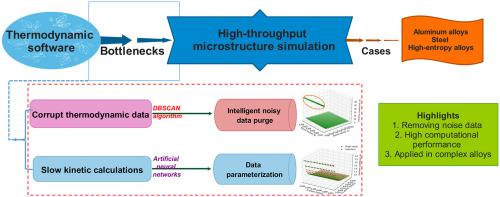Calphad ( IF 2.4 ) Pub Date : 2020-12-03 , DOI: 10.1016/j.calphad.2020.102231 Yue Li , Bjørn Holmedal , Boyu Liu , Hongxiang Li , Linzhong Zhuang , Jishan Zhang , Qiang Du , Jianxin Xie

|
The coupling of computational thermodynamics and kinetics has been the central research theme in Integrated Computational Material Engineering (ICME). Two major bottlenecks in implementing this coupling and performing efficient ICME-guided high-throughput multi-component industrial alloys discovery or process parameters optimization, are slow responses in kinetic calculations to a given set of compositions and processing conditions and the quality of a large amount of calculated thermodynamic data. Here, we employ machine learning techniques to eliminate them, including (1) intelligent corrupt data detection and re-interpolation (i.e. data purge/cleaning) to a big tabulated thermodynamic dataset based on an unsupervised learning algorithm and (2) parameterization via artificial neural networks of the purged big thermodynamic dataset into a non-linear equation consisting of base functions and parameterization coefficients. The two techniques enable the efficient linkage of high-quality data with a previously developed microstructure model. This proposed approach not only improves the model performance by eliminating the interference of the corrupt data and stability due to the boundedness and continuity of the obtained non-linear equation but also dramatically reduces the running time and demand for computer physical memory simultaneously. The high computational robustness, efficiency, and accuracy, which are prerequisites for high-throughput computing, are verified by a series of case studies on multi-component aluminum, steel, and high-entropy alloys. The proposed data purge and parameterization methods are expected to apply to various microstructure simulation approaches or to bridging the multi-scale simulation where handling a large amount of input data is required. It is concluded that machine learning is a valuable tool in fueling the development of ICME and high throughput materials simulations.
中文翻译:

通过机器学习实现复杂成分合金的高通量微观结构模拟
计算热力学和动力学的耦合一直是集成计算材料工程(ICME)的中心研究主题。实现这种耦合和执行有效的ICME指导的高通量多组分工业合金发现或工艺参数优化的两个主要瓶颈是动力学计算对给定的一组成分和工艺条件以及大量质量的慢响应。计算的热力学数据。在这里,我们采用机器学习技术来消除它们,包括(1)智能损坏数据检测和重新插值(即 数据清洗/清洗)到基于无监督学习算法的大型列表热力学数据集,以及(2)通过人工神经网络将清除的大型热力学数据集参数化为包含基本函数和参数化系数的非线性方程式。两种技术可以使高质量数据与以前开发的微观结构模型有效链接。所提出的方法不仅通过消除由于获得的非线性方程的有界性和连续性引起的损坏数据的干扰和稳定性而提高了模型性能,而且还显着减少了运行时间并同时减少了对计算机物理内存的需求。高计算稳健性,效率和准确性是高吞吐量计算的先决条件,通过多组分铝,钢和高熵合金的一系列案例研究得到了验证。拟议中的数据清除和参数化方法有望应用于各种微观结构仿真方法或桥接多尺度仿真,其中需要处理大量输入数据。结论是,机器学习是推动ICME和高通量材料仿真发展的宝贵工具。



























 京公网安备 11010802027423号
京公网安备 11010802027423号